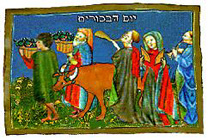

 The
Hebrew term bikkurim derives from the same root as bekhor
— firstborn (bikkurim are also referred
to in certain instances as reshit —
the first.) According to the same general principle that the firstborn
of man and beast belonged to the God of Israel and were to be devoted
to him, the first fruits to ripen each season were to be brought as
an offering to God (see Lowin's article
on the Hebrew root-word b-kh-r)[*].
According to rabbinic interpretation, the duty of bringing first fruits
was confined to the seven species growing in Erez Yisrael: wheat, barley,
grapes, figs, pomegranates, olive oil and dates (the latter referred
to as dvash — honey). Every Israelite
who possessed the means of agricultural productivity was under this
obligation. The
Hebrew term bikkurim derives from the same root as bekhor
— firstborn (bikkurim are also referred
to in certain instances as reshit —
the first.) According to the same general principle that the firstborn
of man and beast belonged to the God of Israel and were to be devoted
to him, the first fruits to ripen each season were to be brought as
an offering to God (see Lowin's article
on the Hebrew root-word b-kh-r)[*].
According to rabbinic interpretation, the duty of bringing first fruits
was confined to the seven species growing in Erez Yisrael: wheat, barley,
grapes, figs, pomegranates, olive oil and dates (the latter referred
to as dvash — honey). Every Israelite
who possessed the means of agricultural productivity was under this
obligation.
Deuteronomy contains detailed procedures for the offering of the first
fruits, including a liturgical recitation incumbent upon any who offered
their first fruits in the sanctuary. In Deuteronomy and Numbers, the
descriptions of the procedures for the offering require that the first
fruits be displayed, and later given to the priests as part of their
cultic "salary." Leviticus, on the other hand, speaks of a minhah-bikkurim,
an offering from the first-ripe grains which is to be burnt on the altar.
These and other differences between the different books of the Torah
leave certain gaps in our understanding of how exactly the rites connected
with the first fruits were carried out.
 The
offerings of first fruit were both an individual obligation and part
of a public festival celebration. A sheaf of the new barley harvest
(omer) was offered on the second day of the Passover festival.
Particularly associated with the bringing of first fruits was the celebration
of Shavuot, also called Hag ha-Bikkurim —
"the first fruits festival." According to the Mishnah (Bikkurim 1, 6,
9), in Second Temple times the pilgrimage to the Temple for the purpose
of offering the first fruits could be undertaken anytime between Shavuot
in the late spring, and Sukkot in the fall; the festival of Shavuot,
however, was the first date of this offering. The
offerings of first fruit were both an individual obligation and part
of a public festival celebration. A sheaf of the new barley harvest
(omer) was offered on the second day of the Passover festival.
Particularly associated with the bringing of first fruits was the celebration
of Shavuot, also called Hag ha-Bikkurim —
"the first fruits festival." According to the Mishnah (Bikkurim 1, 6,
9), in Second Temple times the pilgrimage to the Temple for the purpose
of offering the first fruits could be undertaken anytime between Shavuot
in the late spring, and Sukkot in the fall; the festival of Shavuot,
however, was the first date of this offering.
The Mishnah (Bikkurim
3:2-9) vividly describes the first fruit offering ceremony in the period
of the Second Temple. The people walked in procession headed by an ox
whose horns were adorned with gold and silver wreaths and with olive branches.
The pilgrims were accompanied by musicians playing the flute. Rich people
took the first fruits in baskets of silver and gold, while the poor carried
their fruit offerings in wicker baskets made of peeled willow branches
(which they gave to the priests together with the fruits). The baskets
contained the choicest fruits and the pigeons, perched on top, were later
sacrificed at the Temple. Those who lived close to Jerusalem brought fresh
fruit and those who lived far, dried fruit.
|